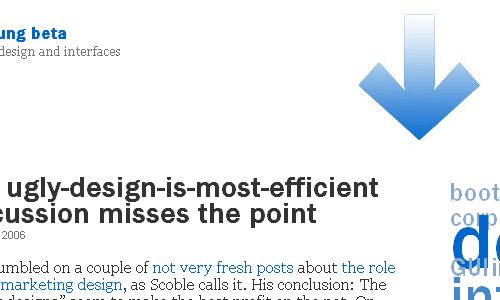
Der geradezu gespenstische Erfolg eher hässlicher Websites ist eine intellektuelle Herausforderung für jeden Designer, vor allem natürlich für Web-Designer. Christian Jung gehört zu denen, die sich dieser Herausforderung stellen.
Whats the nature of the web? A powershift. The web makes easy access to information to everyone. […] The web shifts a part of the power from companies and institutions to the individual. That’s great and therefore we all love the internet.
Design has its root in the opposite direction. Design is visible authority. Design is expensive, not everyone can afford it. Authorities always used design to make their power visible. Any designer must be reminded that the toolset we are using has its origin in expressing power within a society.
Natürlich beschreitet Christian einen eleganten Ausweg aus diesem Widerspruch.
Design must simply respect the web’s nature: gathering information, connecting with other people. There are a lot of examples (flickr is the best in the web2.0 context) that show this can be achieved without producing ugliness. Designing web is more about thinking about functions and how to use them best. Designers must stand back from their vanity and rethink their tools.
Jason Santa Maria fühlt sich zu einer ausführlichen Replik provoziert:
Good design is certainly not only something visually beautiful. I will yell it from the rooftops, design is communication! Which means: design is writing, design is organization, design is usability, and on and on. Design encompasses much more than you think. If you are still clinging to the idea that design is merely decoration, or that something has to be visually appealing to be successful, you are as thick as the mud you’ve been flinging.
Christian Jung leitete das Experience Design von SinnerSchrader und seit 2004 von SinnerSchrader Neue Informatik. Auf dem Thementag 2005 referierte er über die Geschichte der nutzerorientierten Anwendungsentwicklung. Heute arbeitet Christian Jung bei CoreMedia.